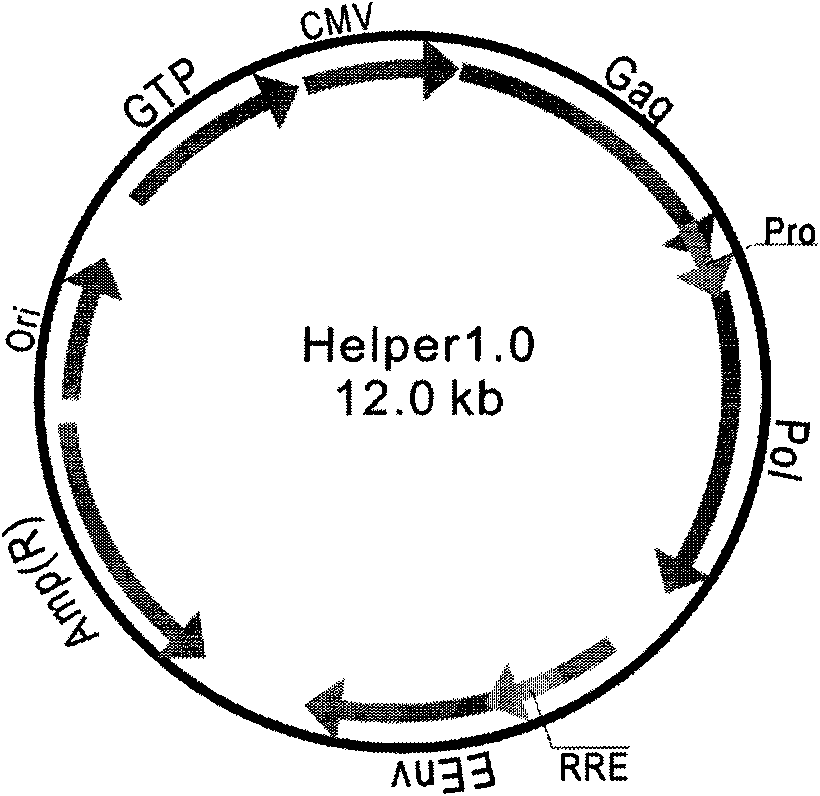Construction of recombined lentivirus vector aiming at PKC gamma gene RNA interference and application thereof
A recombinant lentivirus and RNA interference technology, applied in the fields of molecular biology and biomedicine, can solve the problems of gene expression silencing, unable to guide the synthesis of proteins, etc., and achieve the effect of good effect, no toxic side effects and low cost.
- Summary
- Abstract
- Description
- Claims
- Application Information
AI Technical Summary
Problems solved by technology
Method used
Image
Examples
Embodiment 1
[0077] Example 1: Design and synthesis of DNA targeting ShRNA
[0078] According to the PKCγmRNA sequence (NCBI 012628), the sense and antisense strands of the following nucleotide sequences were designed and synthesized according to Ambion online software.
[0079]PSCSI625:
[0080] Sense strand: 5'-CCGGCAGAAGACAAAGACCGTGAAATTCAAGAGATTTCACGGTCTTTGTCTTCTGTTTTTG-3'
[0081] Antisense strand: 3'-GTCTTCTGTTTCTGGCACTTTAAGTTTCTCTAAAGTGCCAGAAACAGAAGACAAAAACTTAA-5'
[0082] PSCSI626:
[0083] Sense strand: 5'-CCGGGAAGTTTGAGGCCTGTAATTATTCAAGAGATAATTACAGGCCTCAAACTTCTTTTTG-3'
[0084] Antisense strand: 3'-CTTCAAACTCCGGACATTAATAAGTTCTCTATTAATGTCCGGAGTTTGAAGAAAAACTTAA-5'
[0085] PSCSI627:
[0086] Sense strand: 5'-CCGGAACTCTATGCCATCAAGATACTTCAAGAGAGTATCTTGATGGCATAGAGTTTTTTTG-3'
[0087] Antisense strand: 3'-TTGAGATACGGTAGTTCTATGAAGTTCTCTCATAGAACTACCGTATCTCAAAAAAACTTAA-5'
[0088] PSCSI628:
[0089] Sense strand: 5'-CCGGCAGACTACATAGCACCTGAGATTCAAGAGATCTCAGGTGCTATGTAGTCTGTTTTTG-3' ...
Embodiment 2
[0096] Embodiment 2: Construction of recombinant plasmid
[0097] The process of constructing recombinant plasmids is as follows Figure 11 As shown, take 5 μg each of the sense chain and antisense chain synthesized and purified in Example 1, and anneal to form complementary double chains. Any of the above complementary double chains can be connected to the vector pGCSIL-GFP. 15mL / L non-denaturing polyacrylamide gel electrophoresis (polyacrylamide gel electrophoresis PAGE) gel was used to detect the double-strand formation efficiency, and the pGCSIL-GFP / U6 vector (purchased from Shanghai Jikai Gene Chemical Technology Co., Ltd.) was digested with AgeI and EcoRI To linearize them, large fragments were recovered by gel electrophoresis. The large fragments recovered from the plasmid vector were ligated with the synthesized DNA with T4 phage DNA ligase, transformed into competent bacteria DH5α, and the recombinant positive clones were picked for PCR and sequencing identification ...
Embodiment 3
[0101] Embodiment 3: RNAi lentiviral packaging
[0102] 1. Virus packaging (see Figure 12 )
[0103] Prepare recombinant viral plasmids encoding lentiviral particles and their two auxiliary packaging element vector plasmids, namely pGCSIL-GFP / U6-Sh PKCγ recombinant vector, pHelper 1.0 (gag / pol element) vector, pHelper 2.0 (VSVG element). The three kinds of plasmid vectors were extracted with high purity and no endotoxin respectively, and were co-transfected into 293T cells according to the instructions of Invitrogen Lipofectamine2000. After 8 hours of transfection, the complete medium was replaced. After 48 hours of culture, the cells rich in lentiviral particles were collected. The supernatant was concentrated to obtain a high-titer lentivirus concentrate, and the virus titer was measured and calibrated in 293T cells. Lentiviral particles within a certain titer range can meet the needs of most in vivo and in vitro experiments.
[0104] Cell line 293T, the packaging cell o...
PUM
| Property | Measurement | Unit |
|---|---|---|
| Titer | aaaaa | aaaaa |
Abstract
Description
Claims
Application Information
 Login to View More
Login to View More - R&D
- Intellectual Property
- Life Sciences
- Materials
- Tech Scout
- Unparalleled Data Quality
- Higher Quality Content
- 60% Fewer Hallucinations
Browse by: Latest US Patents, China's latest patents, Technical Efficacy Thesaurus, Application Domain, Technology Topic, Popular Technical Reports.
© 2025 PatSnap. All rights reserved.Legal|Privacy policy|Modern Slavery Act Transparency Statement|Sitemap|About US| Contact US: help@patsnap.com



